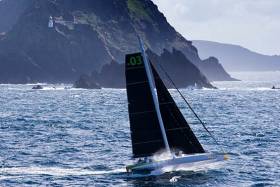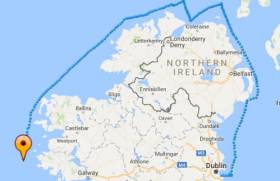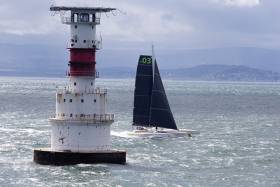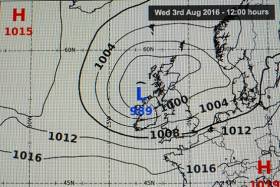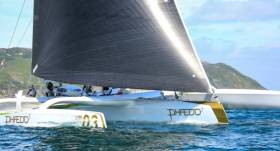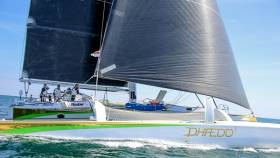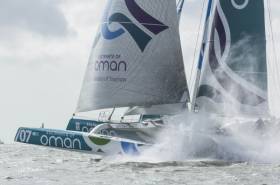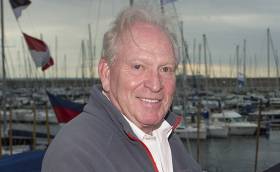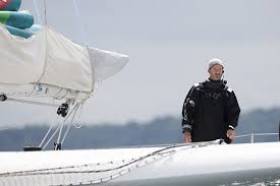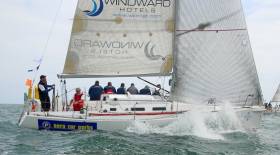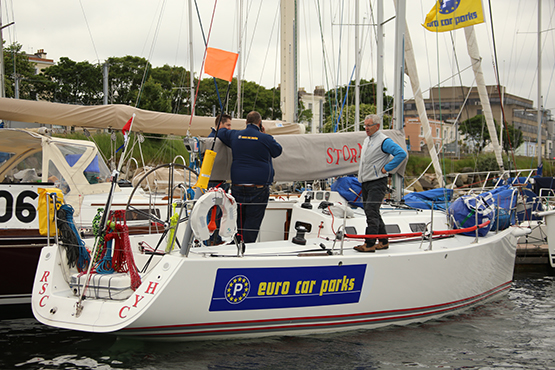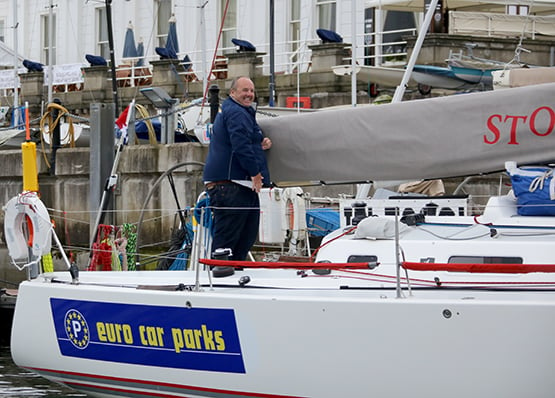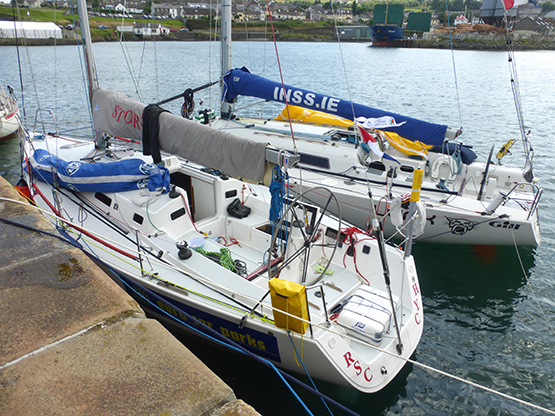Displaying items by tag: Round Ireland
Race to The East Coast for Phaedo 3 Before Wind Dies (VIDEO)
Having left Dublin Bay (Kish lighthouse) at approximately 3pm yesterday (Wednesday), American trimaran Phaedo3 is now two–thirds of the way round their anti–clockwise Round Ireland record bid. TRACKER here.
The crew, led by skipper Lloyd Thornburg, are currently gybing downwind towards the Fastnet rock and the sun is shining on the 70–ft trimaran. The time to beat is Oman Sail's June record of 38 hours, 37 minutes and 7 seconds.
While progess to date has been good thus far, things look a bit soft for the international crew this evening on the east coast between the Kish light finish and the Tuskar Rock, but they’ve quite a good margin in hand.
It's important now that they get to the East coast before the wind dies.
Phaedo Approaches Halfway Stage In Round Ireland Speed Challenge
Lloyd Thornburg’s MOD 70 was past Achill Island in Mayo this morning by 0700 in her anti-clockwise Round Ireland record attempt, which began at Dublin Bay Bay’s Kish Lighthouse at 3.0 pm yesterday afternoon writes W M Nixon. But though she had more wind than she needed for much of yesterday, the sting has gone out of the westerly breeze off the Connacht, coast and off Clew Bay at 0710 hrs she was doing a relatively modest 15.1 knots on track southward. See tracker here.
With the fresh winds veering towards west to nor’west as she came onto the north coast, as expected Phaedo had to beat from Torr Head to Malin Head. But with her enormous speed potential, it was an advantage that the tide was flooding adversely southeast into the North Channel, as it this eliminated the area’s Maelstrom-like conditions when it’s wind over tide, and the boat’s extraordinary speed enabled her to offset strong adverse tidal stream.
Phaedo showed her quality by taking just four hours and forty minutes to beat from Torr Head (where she was making 19.3 nots) to Malin Head, and with Malin finally astern at 00.40 hrs this (Thursday) morning, she was finally able to lay the course past Tory Island and then free still further for potentially faster progress towards the northwest headlands of Mayo.
But with the sea state somewhat confused after two days of strong winds, and the bite in the nor’west and then westerly breeze sometimes weakening, she hasn’t always been at her full speed potential. Though she was at 25.7 knots approaching Achill Head at 0640 this morning, once past it the pace slackened for a while, but now at 07.35 things are looking up again, and she’s making 29.1 knots
Phaedo 3 Trimaran Blast Off on Round Ireland Record Attempt
Phaedo3 has just blasted through the start line of the official WSSRC course for the 'Round Ireland' record, in attempt to set a new time. With winds of over 20 knots, gusting 30 they speed through the line right beside Kish lighthouse on Dublin Bay in an anti–clockwise direction with the hope of breaking the existing record.
Lloyd Thornburg and his team tried to keep this record attempt under wraps, but now the secret is well and truly out. The boat and crew are fresh from winning the Round Island Race in the UK, in which saw the boat smashing Sir Ben Ainslie’s record, and setting a new record of just 2 hours 23 minutes and 23 seconds, for speed sailing round the Isle of Wight.
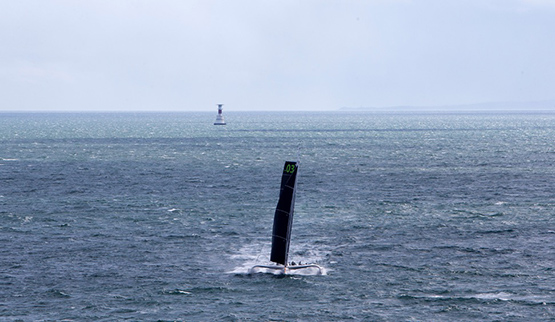 Phaedo 3 on her way northabout on a Round Ireland Record mission. Photo: Rachel Fallon–Langdon
Phaedo 3 on her way northabout on a Round Ireland Record mission. Photo: Rachel Fallon–Langdon
The team were last in Ireland for the Volvo Round Ireland Race, where after leading for the last leg, got pipped at the post by a few minutes by their fellow MOD70 Oman. The current WSSRC record is held by the MOD70 Oman when they crossed the Volvo Round Ireland Race finish line at Wicklow in just 38 hours, 37 minutes and 7 seconds.
Phaedo3 say they hope to knock a couple of hours off this record.
Crew on board for the race: Lloyd Thornburg - helm, Brian Thompson - Co-Skipper, Miles Seddon - Navigator, Damian Foxall - Bow, Paul Allen - Trim, Sam Goodchild - Trim, Henry Bomby - Grinder, Fletcher Kennedy - Grinder
Phaedo3 tracker is here
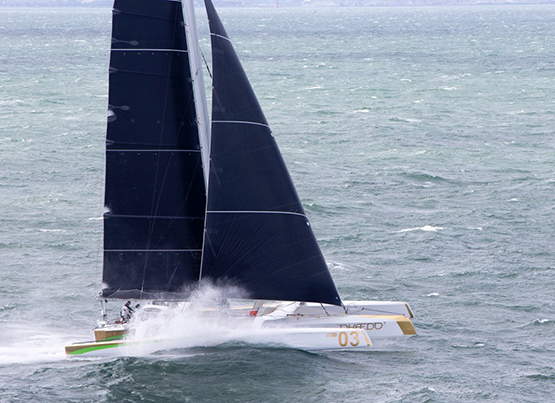 Phaedo3 has just blasted through the Dublin Bay start line Photo: Rachel Fallon-Langdon
Phaedo3 has just blasted through the Dublin Bay start line Photo: Rachel Fallon-Langdon
If we’re going to have this abominable weather for the first week of August on the fronts and backs of the weaving Jetstream, then somebody might as well do something useful with it writes W M Nixon. So here’s cheers to Lloyd Thornburg and his crew on the MOD 70 Phaedo 3 as they gather themselves in Dun Laoghaire to rocket out to the Kish Lighthouse and get timed on their way by NYC Commodore Larry Power for yet another tilt at the magnificent challenge of the Round Ireland Record. Tracker here
Time is of the essence, for as the noon pressure map shows, a low of 989 (already up from its lowest of 987) is currently tightly bunched at Tory Island, giving favourable winds northward through the Irish Sea and North Channel. But as the low continues to march eastward off Ireland’s north coast, it’s going to continue losing the depths of its central pressure – albeit slowly - the isobars will start to spread, and what had been strong winds can become messy stuff all over the place surprisingly quickly.
Assuming they’re going anti-clockwise, the idea is to reduce the tricky bit on the North Coast from Rathlin Island to Malin Head to as quick a sail as possible, as there’ll be more favourable nor’westers beyond Malin for a while.
It should be remembered that a lot of time was lost during the clockwise Volvo Round Ireland Race on the south coast with the long board taken seaward in search of stronger winds, and to make windward progress down to the Fastnet in the earlier southwest wind.
As a result, the three MOD 70s sailed 790 miles to cover the 704 mile course. Yet despite that they chopped a clear two hours off the record to bring it down to 38 hours 37 minutes. So a time of 30 hours – okay, let’s say 33 – is theoretically possible.
Lloyd Thornburg has a crew of all the talents, as he has Brian Thompson who set the beautiful Lakota record with Steve Fossett in 1993, and he also has Damian Foxall who was on Oman Sail when she set the new record at the finish line of the Volvo Round Ireland Race on June 20th.
But Foxall was also on Oman when she flipped during the Quebec Transatlantic race to France on July 17th, so he knows only too well how much on the edge you are with these boats when pushing to the limit, and this will be a continuous theme if this challenge is going to be a success.
The seas are tide-riven and turbulent the whole way from the South Rock at the south end of the North Channel on past Rathlin, continuing potentially rough to very rough until you’re well beyond Malin Head.
And then out there in the open Atlantic, even if you do catch a useful amount of the strong north’westers on the back of the low, you’ll find the strong to gale force sou’westers of the past couple of days have provided a leftover head sea which may never completely disappear, for after a while it is presaging the next lot of bad weather coming in from mid-Atlantic.
It’s a complex and fast-changing meteorological scene out there. But the message from this weather map at noon Wednesday seems to be that they should be on their way northward from Dublin Bay right now
Round Ireland Speed Record Tracker CLICK HERE!
Track the Round Ireland speed record attempt by the MOD70 Phaedo3 Lloyd Thornburg below.
The record time to beat is: 38 hours, 37 minutes and 7 seconds.
Stay tuned to the Yellowbrick tracker below.
Another Round Ireland Speed Record Bid?
There are unconfirmed reports that the MOD70 Trimaran Phaedo3 will make a further bid at the Round Ireland Speed Record this month. The MOD70 skippered by American Lloyd Thornburg is understood to be considering a return to Ireland to make a further bid on the 700–mile record time set by Oman Sail during last month's Round Ireland Race. In a thrilling three way duel Thornburg's crew were edged out of the honours in an Irish Sea battle on June 20th.
The historic new record for the fastest-ever sail round Ireland was set when Oman Sail crossed the Volvo Round Ireland Race finish line at Wicklow on June 20th in just 38 hours, 37 minutes and 7 seconds, smashing their own 2015 record by an incredible 2 hours, 14 minutes and 50 seconds. The new time is subject to ratification by the World Speed Sailing Record Council.
Earlier this month, Phaedo 3 set a new record round the Isle of Wight. Omansail capsized at the weekend while her crew were attempting to set a new transatlantic record.
Fresh from setting a stunning new Round Ireland record in June, County Kerry's Damian Foxall and his Musandam-Oman Sail team have set their sights on another milestone record in the Transat Quebec-St Malo (TQSM) with a match against the world’s largest trimaran Spindrift 2 expected to push them to the limit.
The Omani MOD70 – which at 70 foot (21m) is almost half the size of Spindrift 2 (130ft/40m) and will be crewed by seven fewer sailors – will leave Quebec in Canada on Wednesday at 1500 local time and head out on the 2,897 nm (5365 km) course across the North Atlantic to St Malo in France with the aim of breaking the existing record of 7 days 20 hours and 24 minutes set in 1996 by Loïck Peyron.
The forecast for the passage looks favourable for a new record and the prospect of a battle against Spindrift 2 was creating a real buzz among French skipper, Sidney Gavignet’s crew of Damian Foxall, Fahad Al Hasni, Alex Pella and new crewmember Mayeul Riffet, as they prepared for the off.
“Spindrift 2 is wider than we are long!” commented Gavignet who has completed three TQSM races in his career.
“We have beaten them in the past during the Round Britain and Ireland where there are lots of corners, but an Atlantic crossing is more like an Autobahn and with a speed difference of up to 5 knots, they will be very hard to beat.
“They should beat Loïck Peyron’s record and Musandam-Oman Sail also has a chance to finish ahead of 7 days, 20 hours and 24 minutes.”
Before the David and Goliath match begins on the open seas, the team will have to navigate the spectacular St Lawrence River which is dotted with sand banks, logs and various whales and is regarded as a navigator’s challenge.
“We saw a boat grounded at the monohull start and on our way in, we saw two minkies, a hump back and a bunch of belugas so we are going to have to be diligent,” warned Foxall.
“It will take us a couple of days to get down to the Grand Banks and they are allowing us to cut across the Banks on a route where there is less ice which will be good news if we want to get the record. There is also a series of lows coming off Canada to create the train we need to blast across the Atlantic.
“The conditions are looking fantastic so I think it is currently looking like less than seven days. Hopefully both Musandam-Oman Sail and Spindrift can set new records.”
Fantastic conditions do not necessarily mean comfortable conditions, added Gavignet so with the icebergs, big seas and marine life, they are in for a great adventure.
“For us the conditions will feel extreme; we are constantly soaking wet and to get from the cockpit to the helm, we will be crawling on our hands and knees. We are all very competitive so we will be aiming to have the best possible adventure and the best possible race.
“For a sailor, the Quebec-St Malo is one of the classics; it is like rounding Cape Horn or the Cape of Good Hope, it is one of the mythical races in a sailor’s career.”
Oman’s leading offshore sailor Fahad Al Hasni is no stranger to transatlantic races and started his helming career on Oman Sail’s first race in their MOD70, the Krys Ocean Race from New York to Brest in 2012.
“It was my first transatlantic and I remember being very cold and wet so this time I know what to expect and I’m really excited about it,” he said.
“We will be downwind all the way across the North Atlantic to the Fastnet Rock and then over to St Malo for the finish. The weather is looking good for a record so hopefully, we can get our second record for Musandam-Oman Sail this year.”
The Transat Québec - Saint Malo is staged every four years and in 2016 has attracted 24 entries, both monohulls and multihulls, from across the world. The bulk of the fleet started their race on Sunday but Musandam-Oman Sail and Spindrift 2, both competing in the ‘Ultime’ class start on Wednesday in the hope that the entire fleet will be nearing the finish in St Malo at around the same time.
Last month, Musandam-Oman Sail set a new Round Ireland record when they beat two other MOD70s Phaedo 3 and Concise 10 to win the Volvo Round Ireland Race, setting a new time of 38 hours 37 minutes and 7 seconds, which was more than two hours faster than their previous time of 40 hours, 51 minutes and 57 seconds set the previous year.
The Transat Quebec-St Malo 'Ultime Class' start is at 1500 local time on Wednesday 13 July.
There was something otherworldly and very special about the mighty silver bullet from the moment she arrived in Ireland, berthing quietly in Dun Laoghaire in the countdown to the Volvo Round Ireland Race at Wicklow on June 18th. George David’s Juan K-designed Rambler 88 is just about the most understated colour you could have for a boat. Yet from the moment she appeared, there was no doubting that Rambler 88 was something very special, and the combination of quiet yet undoubted potential with the sheer enthusiasm of her veteran owner made for an irresistible combination.
But the mythology was only starting to build. The actual start, with the mighty Rambler somehow finding her way through a milling fleet of much smaller craft to make a wellnigh perfectly on-time beginning, was to set us all off on the sail of a lifetime. It’s very rarely that a Maxi will figure at the front of a corrected time leaderboard as a race with a fleet of 63 diverse boats moves itself along the course. But it was only for a while far to seaward of the south coast as she sought the freshening wind that Rambler 88 was not leading on corrected time, and of course she was out of sight in terms of mono-hull line honours.
When the freshening wind arrived, it was to give the bulk of the fleet still struggling down to the Fastnet quite a pasting. But Rambler 88 was gone, tearing up the west coast at record speed. Unlike the MOD 70s, she’d only herself to race against, and it says much for the keenness George David engenders in his very international crew that the pace never slackened for a moment, while every tactic was called with successful precision.
This virtue was rewarded with a freeing westerly wind as she entered the Irish Sea on Monday morning, and Rambler 88 was able to lay towards the finish 90 miles away with sheets increasingly eased. She may have missed getting round Ireland in less than two days by a couple of hours. But the fact that we should even have thought of such a crazy possibility only serves to emphasise what an extraordinary performance Rambler 88 logged, with every mono-hull record shattered and the overall win on IRC confirmed in due course. George David’s promised return to Ireland far exceeded anyone’s expectations in terms of leadership inspiration and team achievement, and he is an Afloat.ie International Sailor of the Month for June.
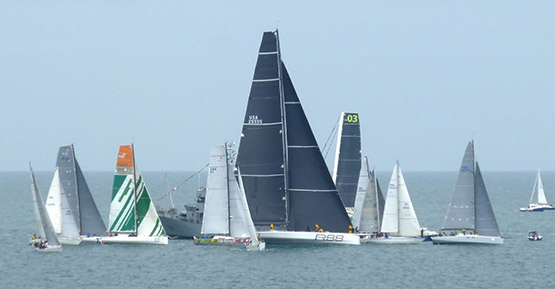
When three MOD 70s swept through the starting line at Wicklow on Saturday June 18th for the Volvo Round Ireland Race, so much work behind the scenes had gone into bringing this very special trio to Ireland’s premier offshore racing event that it would be easy to forget that the first seeds of this remarkable lineup were planted some years ago by our own sailing superstar, Damian Foxall of Derrynane in County Kerry.
Thanks to his rising status in the high-powered French multi-hull scene, Foxall was able to bring the challenge of the Round Ireland Record up their agenda, and at every possible opportunity, he encouraged his most regular multi-hull skipper, Sidney Gavignet with Musandam-Oman, to slot the possibility of a Round Ireland sprint into the busy annual schedule.
Foxall’s powers of persuasion must be really remarkable, for it was after no less than three attempts, when the challenges were called off as the weather failed to develop as expected, that Gavignet finally cracked it at the beginning of May 2015.
But by a cruel irony, Damian Foxall wasn’t on board, as he had been pre-booked to fill a key role in a Volvo World Racer. Thus the Round Ireland remained unfinished business in the Foxall CV, while other MOD sailors reckoned that Gavignet’s new time was beatable.
With this new consciousness burgeoning about the Round Ireland challenge, as soon as Wicklow SC confirmed there would be a proper multihull division in 2016 race, the MOD 70 wheels started turning. But few would have been so optimistic as to predict that three of these magic machines would turn up in Wicklow, and even fewer would have predicted that all three would blow away Musadnam-Oman’s 2015 time.
To make the fantasy nature of it complete, it emerged that neither Damian Foxall who was sailing on Musandam-Oman, nor Justin Slattery who was aboard Phaedo 3, had any experience of doing this long-established race from Wicklow round their homeland. They were Round Ireland Virgins, having both been so busy building their careers at the very top level of the international circuit that the Round Ireland had simply never come up on the radar before.
Well, it’s very much on the radar now, after the race of a lifetime. For much of it, Ned Collier Wakefield with Team Concise led narrowly from Phaedo 3, with Musandam-Oman spending rather more time in third slot than her supporters might have liked. But in the final dozen miles, it started to come right, and perfectly called tactics saw her take the first place in style as dawn began to break on the Monday. Damian Foxall is very deservedly one of the winners of an Afloat.ie International Sailor of the Month Award for June 2016.
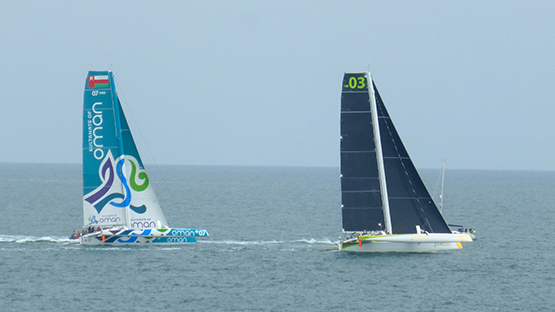
Taking a charter boat with old sails, borrowing a few other sails, filling it with a crew whose average age is nearly 50 might not sound like a recipe for success against some full–on campaigns but when Howth YC skipper David Cullen put six ICRA National Champions in his crew line up he was always going to be a potent force. Here, Cullen describes how his J109 Euro Car Parks entry was the only Irish class winner of this month's Volvo Round Ireland Race.
With the big Five Oh approaching, I felt it was time to revisit a challenge that I hadn’t participated in for 18–years so decided to participate in this year’s Volvo Round Ireland Race. Perhaps my close interest in following the Volvo Ocean Race was part of the inspiration or perhaps the start of a mid-life crisis, but regardless of why it was time to put the best campaign affordable together.
As my own half tonner Checkmate was too small (even though I did one previously in a half tonner), it was time to look at the charter route. Given Rambler 88 was a certainty to steal the monohull line honours prize, I decided early on that the goal should be a class win on IRC.
Inspection of the previous two races results showed a narrow defeat of a J109 in the last race so this seemed to be a good option. At that time, there were no JPKs entered so this looked like a realistic proposition and I didn’t have to look much further than my own Howth Yacht Club to find Storm which is one of Ireland’s leading J109s.
Above and below: Pre–race preparations along side at the Royal Irish Yacht Club in Dun Laoghaire. Photo: Afloat.ie
With a deal done, then it was time to assemble a crew. With a core crew from Checkmate to include Aidan Beggan, John Murphy, Gary Cullen, Eddie Bourke and Franz Rothschild, I needed some J109 expertise to bolster the crew. I regard one of my better moves as recruiting Mark Mansfield and Maurice “Prof” O’Connell to bring along their significant J109 boat speed experience which paid off handsomely.
Prof had just come from a class win in ICRA Nationals class zero aboard Jump Juice. Mark had, for the second year, just won ICRA class one aboard J109 Joker II. Both were obviously in good form and both had vast experience of setting up and sailing J109’s quickly. Added to that both were well known drivers. In offshore racing, drivers and trimmers with a good navigational plan is what makes the difference.
Crew complete, it was now time to start the crew and boat preparations. Not realising the safety requirements for the race, several of the crew were quickly enlisted in First Aid, VHF and Sea Safety courses. These were all very enjoyable and valuable and in retrospect, I am sorry I did not complete these years ago. I cannot recommend these courses enough even if you are not going offshore as surprising how little we actually knew despite the huge miles we had all logged.
We then moved on to the boat preparations. As Storm was an inshore boat it didn’t have a Code Zero which I ordered from Norths so we had a complete suite of sails (along with a bit of borrowing). Next was to organise the financials. I had an original budget of €20k but this ended up closer to €35k so I was glad of the support of Euro Car Parks and Windward Hotels to supplement the costs. The boat was rechristened Euro Car Parks for the race.
With an average age of 48, we weren’t taking any short cuts on safety so I installed all new safety equipment, harnesses, EPIRB, flares etc for peace of mind. Ocean Safety also assisted in this aspect.
We then spent two weeks getting the boat ready for sea. As the J109 is not really an offshore boat, we devised ingenius additional bunks and sleeping arrangements whilst replacing many of the high load bearing systems and adding a bobstay to the pole. We completely underestimated the time required for preparing the boat and several midnight work parties meant we started the race tired which is a lesson for next time. AIS and wifi was added so we could run Expedition on the laptop and also comms were improved to enable data to get forecasts, grib files, etc.
Food was our next thought and Franz took on the role of provisioner and chef. Decision was to go the pressure cooker route with frozen meals and nobody could fault his food choices.
Our IRC Championships the week before the race left us with little boat practice but six of the crew started as IRC Champions from various boats so the pedigree was good.
Before the race, Paul O’Higgins purchased a JPK1080 Rockabill VI which was favourite for our class but there were several other boats including some experienced J109s so we weren’t sure where we would end up but podium was a definite goal.

Euro Car Parks (pictured above on port tack) was deemed 'on course side' at the start of the race
The forecast the day before the race indicated a light start, reach up the West coast and light finish; all ideal for a J109 and lulling us into a false sense of comfort. What arrived was quite at odds with that forecast.
The morning of the race had c10–knots south westerly which was great for our start, had I not put us over the line at the gun! We had the walk of shame back to the line to restart but at least we got some press coverage, albeit for the wrong reason.

Mark Mansfield and Prof O'Connell shortly after the start
Rambler 88 and the MOD 70s disappeared in the blink of an eye and we were left trying to play catch up with our fleet. It didn’t take us too long to get back into contention but we ended up in an Easterly position when approaching Tuskar Rock which definitely was not the favoured side. That said, although behind, we were back in contention. Our food plans meant the use of spoons and bowls for the race so you can imagine the look on our faces when all the spoons went overboard when emptying a bucket! One teaspoon fed the crew for the rest of the race supplemented by the clever use of Doritos.
As the night drew in, it was clear that we were in for a windy beat along the south coast so we agreed as a crew to push it! All of the crew spent the next 24 hours on the rail in truly miserable conditions of pelting rain and c.30knots of breeze with big seas. We pushed on with full main and a J2 whilst similar boats carried a lot less sail and at the end of the ordeal, we were in contention for first place in Class. Food was cancelled and a staple diet of jelly beans and water kept us going.
"One teaspoon fed the crew for the rest of the race supplemented by the clever use of Doritos"
Whilst the Round Ireland is renowned for the scenery, our roundings of Fastnet, Skelligs and Blaskets were fairly miserable in grey, windy and wet conditions. As we rounded Mizen Head, so did the wind to stay on the nose until we got to Kerry when finally the breeze went abeam and the rain stopped.
A fast beam reach up the west coast was most welcome but also suited Rockabill VI even better, who by Donegal had over an hour advantage on handicap. Proper food reappeared to warm our spirits.
At this point the boat, all of our gear and all of the crew were saturated so a run along the top gave us the opportunity to dry the boat thoroughly and catch up on some rest. Inspired by some loud U2 and Seal, morale improved where we saw ourselves making handicap gains into Rockabill VI and a favourable Northern passage put us ahead by the infamous Rathlin. For a change we made the tidal change at slack tide and with some breeze started the long push south in a light southerly breeze.
Again it was rail time for the beat down the Irish Sea which was in moderate breeze and dry so no real complaints.
We now had Rockabill VI in our sights approaching Rockabill Lighthouse but a dying breeze made for a very difficult night where we were both becalmed several times. Although tempted to drop the hook, we persevered to approach
Dublin Bay at one knot still on the coat tails of the JPK. The Yellow Brick tracker was nearly worn out with our constant tracking and we started to understand the AIS debate on the Volvo Ocean Race.
Approaching Greystones and Wicklow and the infamously calm Six Mile Point, we eeked forward in an increasingly foul tide just long enough to get inshore behind Rockabill VI and about two hours behind them. This was in fact how we finished and with them owing us over 3½ hours, the Class win was ours.
Clearly the race was a big boat affair. the smaller boats including ourselves were virtually on the wind for the whole race, bar from the Skelligs to Rathlin, thats two thirds of the course. The larger boats were able to lay all the way along the west cost without a tack. In the end the breeze also died allowing the larger boats to claim all the podium positions. Some years it is a small boat race, some a big boat race. This year it was for the big ones. Whilst we were never in contention for overall on IRC which was won by Rambler 88, we had been up to third overall but the lighter conditions at the end finished us in a credible fifth overall.
Class 3 winner Euro Car Parks safely back in Wicklow harbour. Photo: W M Nixon
The famous Wicklow Welcome could not have come quick enough after 118 hours and 55 minutes at sea and it wasn’t long before various members of our crew were found asleep in showers, toilets, etc with a beer in their hands!
On reflection, we got several of the decisions right and the choice of boat and crew being the key ones leading to a harmonious and fun trip despite the misery. We even got a chance to revisit “offshore” stories of old that cannot be put to print so we ticked all the boxes.
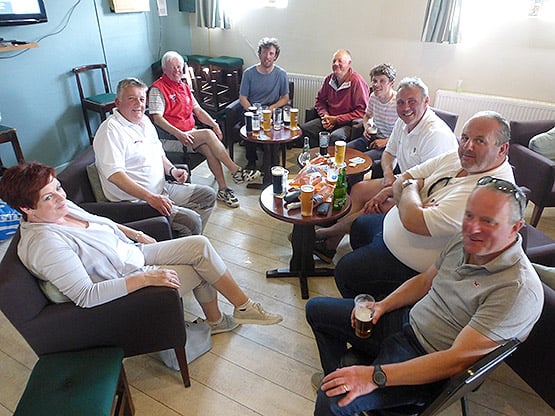
The essential post-race de-briefing – the crews of Euro Car Parks and Rockabill VI, leaders in Class 3, get together in Wicklow SC on Thursday afternoon after five days of racing against each other round Ireland. Photo: W M Nixon
I have two years to decide whether to do it again but I am tempted to go again in a 109 but next time it will be 109 feet!
The next big event for us is to try and retain the Half ton Cup trophy which we won last year. Most of the crew now switch their attentions back to Checkmate for the event in Falmouth in August. Mark, however joins our clubmate Mike Evans on Big Picture for the same event so it will be interesting to see what each of us has picked up from each other over the five days of Round Ireland. Two other well tickled up Half Tonners from Howth, Harmony and King one, will Join us at that event to bring the Irish representation to four boats.
See Round Ireland tracker here Afloat's Round Ireland 2016 coverage is here and download overall results here


























